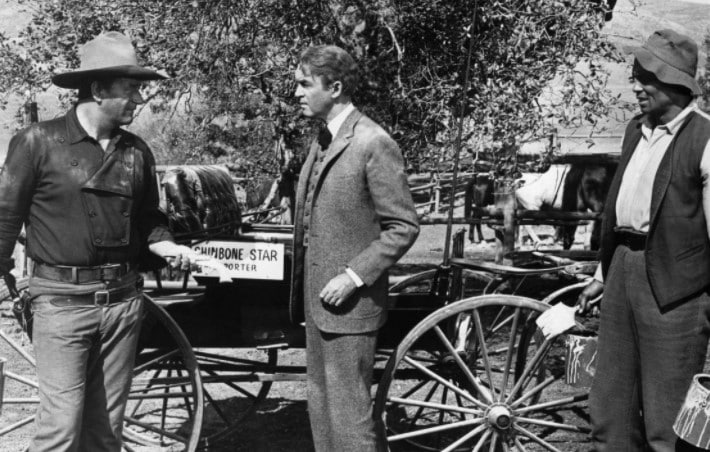John Wayne Was ‘Ready For a Fight’ With His ‘The Man Who Shot Liberty Valance’ Co-Star

The Man Who Shot Liberty Valance is one of John Wayne‘s most iconic roles. However, he didn’t have the most enjoyable time behind-the-scenes. Wayne’s frequent collaborator, John Ford, gave him a difficult time. As a result, he was “ready for a fight” with co-star Woody Strode, who once explained the severity of the situation.
John Wayne plays it tough as Tom Doniphon in ‘The Man Who Shot Liberty Valance’
The Man Who Shot Liberty Valance finds Wayne playing a local man named Tom Doniphon in a small Western town. Senator Stoddard (James Stewart) comes into town for his funeral, which confuses the press. However, the distinguished man tells the story of how Tom helped protect him against a crew of outlaws led by Liberty Valance (Lee Marvin).
Moviegoers embraced Wayne’s signature dialogue delivery. The Man Who Shot Liberty Valance includes one of Wayne’s most iconic words: “pilgrim.” He repeatedly calls Stewart’s Stoddard this, which was an insult within the time period. Nevertheless, Tom maintains Western masculinity as shown in both his narrative and the way the actor plays the part. The character is typically accompanied by his handyman, Pompey (Strode)
John Wayne was ‘ready for a fight’ with co-star Woody Strode
Michael Munn’s John Wayne: The Man Behind the Myth chronicles the iconic actor’s career, including his work on The Man Who Shot Liberty Valance. Ford repeatedly harrassed Wayne on the set with rude remarks that intentionally pushed his buttons. However, the actor took it out on Strode.
“This really pissed Wayne off but he would never take it out on Ford,” Strode said. “He ended up taking it out on me. We had one of the few outdoor scenes where we hightail it out to his ranch in a wagon. He’s driving and I’m kneeling in the back of the wagon. Wayne was riding those horses so fast that he couldn’t get them to stop. I reached up to grab the reins to help, and he swung and knocked me away.”
Strode continued: “When the horses finally stopped, Wayne fell out of the wagon and jumped off ready for a fight. I was in great shape in those days and Wayne was just getting a little too old and a little too out of shape for a fight. But if he’d started on me, I would have flattened him. Ford knew it, and he called out, ‘Woody, don’t hit him. We need him.’”
However, Wayne ultimately calmed down to allow them to continue filming. Nevertheless, Strode felt that “miserable” tension on the set as a result of Ford’s behavior.
“Wayne calmed down, and I don’t think it was because he was afraid of me,” Strode recalled. “Ford gave us a few hours’ break to cool off. Later Wayne said to me, ‘We gotta work together. We both gotta be professionals.’ But I blame Ford for all that trouble. He rode Wayne so hard, I thought he was going to go over the edge. What a miserable film to make.”
James Stewart has top billing on ‘The Man Who Shot Liberty Valance’

The Man Who Shot Liberty Valance ultimately gives Stewart top billing over Wayne in all of the promotional materials. However, the film itself and the theatre marquees place Wayne’s name above his co-star. Some audiences contemplate which role is truly the main character of the story, as they both experience hardship and change.
However, neither actor would get an Oscar nomination for their performances in one of the greatest Western movies ever made. The Man Who Shot Liberty Valance only earned a nomination for Best Costume Design, although it lost to What Ever Happened to Baby Jane? Nevertheless, the movie remains a vital part of cinema history.




